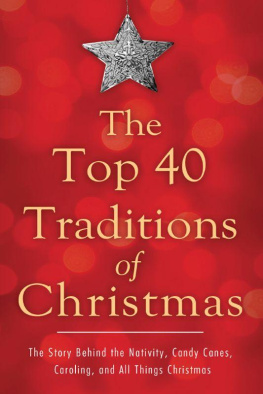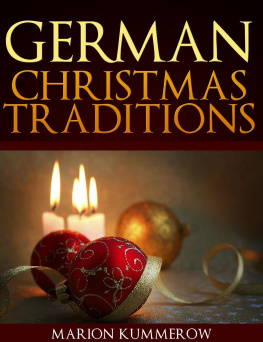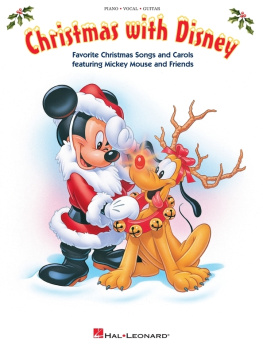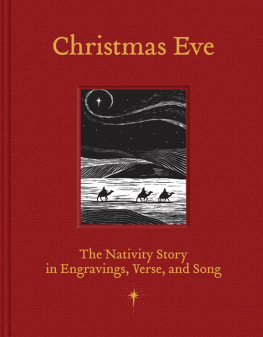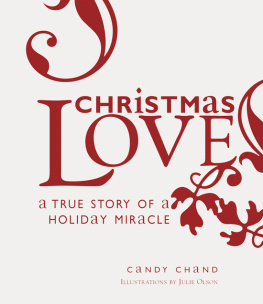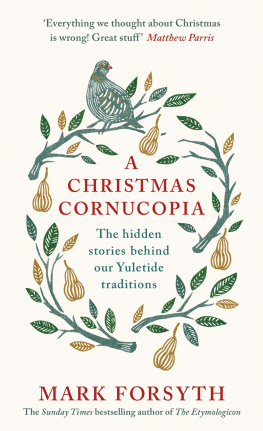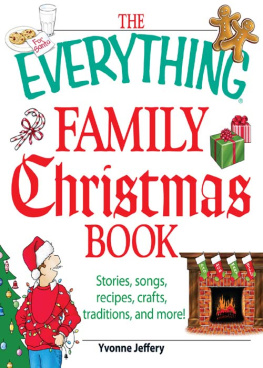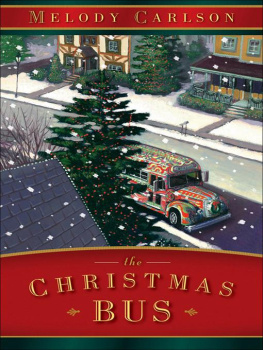
2012 by Barbour Publishing, Inc.
Print ISBN 978-1-61626-860-2
eBook Editions:
Adobe Digital Edition (.epub) 978-1-62029-108-5
Kindle and MobiPocket Edition (.prc) 978-1-62029-109-2
All rights reserved. No part of this publication may be reproduced or transmitted for commercial purposes, except for brief quotations in printed reviews, without written permission of the publisher.
Churches and other noncommercial interests may reproduce portions of this book without the express written permission of Barbour Publishing, provided that the text does not exceed 500 words and that the text is not material quoted from another publisher. When reproducing text from this book, include the following credit line: From The Top 40 Traditions of Christmas, published by Barbour Publishing, Inc. Used by permission.
All scripture quotations are taken from the King James Version of the Bible.
Published by Barbour Publishing, Inc., P.O. Box 719, Uhrichsville, Ohio 44683, www.barbourbooks.com
Our mission is to publish and distribute inspirational products offering exceptional value and biblical encouragement to the masses.

Printed in the United States of America.
Contents
Introduction
Welcome to
The Top 40
Traditions of Christmas!
Christmas traditions form the foundation of the holiday seasonand this book considers the story behind the story for forty favorite customs.
Familiar things like Christmas trees, candy canes, Santa Claus, and lighting displays have little-known histories or deeper meanings that make them worthy of contemplation for those of us who celebrate Christmas as the birth of Jesus Christ, the Son of God.
The Top 40 Traditions of Christmas provides that intriguing information for the most beloved songs, movies, characters, and activities of the season. We hope you enjoy the readings that follow.
And, by the way, Merry Christmas!
1
Advent Calendars
Who?
Early Advent calendars were homemade affairs costing nothing but time and imagination. With the increasing popularity of the tradition, inevitably someone would commercialize it. Hand-drawn calendars were in use as far back as 1851, but the first printed version was made by Munich printer Gerhard Lang in 1908. It came with twenty-four little pictures that could be fixed to the cardboard background. It took several years for the idea of covering the backboard with twenty-four little doors to be introduced.
Langs printing company went out of business twenty years later, but his idea survived and is now a popular part of the Christmas tradition.
What?
The first Advent calendars were simply ways of marking the passing days in the run-up to Christmas. People made chalk marks on their door in excited anticipation of the day the Christ child would come through it.
Gerhard Langs mother stuck sweet treats to a cardboard calendar each morning before he woke. The modern equivalent, which she inspired and he developed, has little boxes with chocolate figures waiting to be uncovered.
Some Advent calendars still have Christmas or faith-oriented scenes behind the chocolate treat, but, in a more secular age, they are often simply images of general celebration or pictures of the celebrities or animated characters endorsing the calendar.
Where?
Like many other Christmas traditions, the Advent calendar was a German invention. It is thought to have originated among Lutheran communities and spread to other churches in the area, but the tradition remained in Germany until the outbreak of World War II. Production of Advent calendars ceased during the war years. Afterward a German manufacturer reintroduced the Advent calendar to the world and helped make it an important part of the modern Christmas.
These days Advent calendars are sold and displayed in most countries where Christmas is celebrated. Being displayed by children from the first day of December, they are the first sign of Christmas in many households.
When?
The Advent season begins on the fourth Sunday before Christmas and ends on Christmas Day. Modern Advent calendars usually begin on the first day of December, with a compartment for that day and each of the next twenty-four. Perhaps in an effort to outsell their competitors, some manufacturers add an extra day for Boxing Day. Some even go as far as New Years Eve. Understandably, children tend to prefer the latter type!
The tradition of marking the days of Advent with some sort of calendar goes back to the beginning of the 1800s, but the period has been marked out as special in one way or another since the fourth century.
Why?
The Advent period has a triple-layered meaning in many churches. Sermons during the four weeks might refer to the time the Jewish people spent waiting for the Messiah or the time Christians spend in anticipation of the Second Coming. Overshadowing both of these is the simple, and very present, anticipation of the celebration of the birth of Christ. Advent or adventus is Latin for coming or approaching.
Advent calendars help renew the excitement of the period every day, with children rushing each morning to see what picture or sweet treat is hidden behind the next door, until Christmas Day arrives.
2
Advent Wreaths
Who?
The practice of making midwinter wreaths was popular in northern Europe in the centuries before Christianity arrived. The Romans, famously, made wreaths of laurel leaves for their champions and leaders. Other people groups made evergreen wreaths.
But it took some creative thinking by German pastor Johann Hinrich Wichern to associate the wreath with the Advent period and develop its Christian symbolism.
Pastor Wichern devoted his life to home missions, traveling all across Germany to establish Sunday schools, childrens homes, and rescue stations for the destitute. He eventually became an inspector of prisons. Pastor Wichern was a Protestant, but before long both Protestant and the Catholic communities had enthusiastically embraced his new idea.
What?
The wreath was traditionally made of evergreen branches woven tightly into a circle. It would be laid horizontally (rather than vertically, as is the tradition in many American homes these days) and decorated with seeds, nuts, and pinecones. Being made virtually fireproof by nature, it made a convenient and attractive setting for candles.
These days many families hang decorated wreaths on their front doors to show they are celebrating Christmas. The horizontal version can still be found in churches, where a candle will be lit for each week of the Advent period. A fifth candle, usually in the middle of the wreath, is often used to represent Christ.
Where?
Originally the candles on the midwinter wreaths made by pagan peoples would have been offerings to tempt the dying sun to come back in springtime. They may have had some Christian associations in the Middle Ages.
Pastor Wichern, who founded a mission school in Munich, is said to have been constantly pestered by the children who wanted to know how long it was until Christmas. So, he set a cart wheel on its side, decorated it with leaves and branches, and placed a candle on each spoke with one in the center. The children got to light a candle each day and so could see Christmas Day, and the last candle, coming ever closer.
Next page
